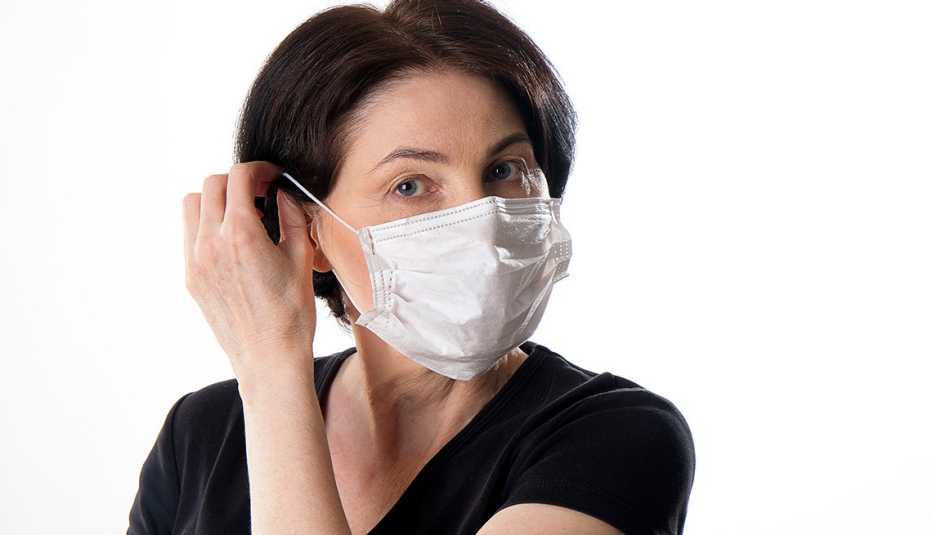Staying Fit


Editor’s Note (July 28, 2021): The Centers for Disease Control and Prevention is now recommending that some vaccinated Americans wear masks — especially those who are in areas where COVID-19 transmission rates are considered high or substantial. Teachers, students, staff and visitors at schools are also encouraged to wear masks, regardless of vaccination status. The guidance was issued on July 27 following new data that show “in rare occasions” some vaccinated people can become infected with the delta variant and spread the virus to others. You can check the CDC's website for a county-by-county look at transmission rates in your region. And you can read the full story on AARP. This story was originally published July 14. 2021.
Vaccinated and wondering whether you should still wear a face mask when out and about?
You're not alone.
Despite the Centers for Disease Control and Prevention (CDC) telling fully vaccinated Americans they no longer need masks in most situations, plenty of people are still wearing them. A poll from Vox and Data for Progress taken shortly after the CDC rescinded its mask guidelines for vaccinated individuals found that more than half of vaccinated people are still wearing masks. Another survey conducted after the CDC's mid-May policy reversal found that 4 in 10 vaccinated individuals continue to mask up.


AARP Membership— $12 for your first year when you sign up for Automatic Renewal
Get instant access to members-only products and hundreds of discounts, a free second membership, and a subscription to AARP the Magazine.
And amid a recent spike in new cases caused by the highly transmissible delta variant, the World Health Organization is urging vaccinated people to keep wearing their masks. Health officials in Los Angeles County and Saint Louis are also recommending residents mask up in public indoor settings, regardless of their vaccination status.
These mixed messages create “a tremendous amount of confusion” when it comes to masks, says Monica Gandhi, M.D., an infectious disease physician and professor of medicine at the University of California, San Francisco.
AARP asked three experts for their best advice on what fully vaccinated adults should be doing. And while there is no one-size-fits-all answer, there are a few things to keep in mind.
1. Know what's happening in your community
One thing is clear: The three federally authorized vaccines are very effective at preventing illness caused by a coronavirus infection. And so far, their defense has proven strong against the emerging variants of concern, including the delta variant, which is now the dominant strain of virus circulating in the U.S. Still, no vaccine is a 100 percent sure thing.
One way to think about the vaccines is like a very good raincoat, says Leana Wen, M.D., an emergency physician and visiting professor of health policy and management at George Washington University's Milken Institute School of Public Health. “If it's drizzling outside, you're going to be fine; you will be protected and not get wet. However, if you keep going in and out of thunderstorms, at some point you could get wet.”
In this analogy, the weather represents the amount of virus circulating in your community. If vaccination rates are high in your area and the number of new COVID-19 cases is still relatively low, the rain is less of a threat. However, many areas of the country, especially where vaccination rates are low, are seeing a spike in new cases, likely caused by the delta variant. “When there's a lot of virus around you, think of that as being in a thunderstorm,” Wen says.
The reason it's important to consider community transmission rates is because breakthrough cases (where a fully vaccinated individual becomes infected), while still rare, are more likely to occur when you're surrounded by more virus, explains Gandhi, pointing to the wave of breakthrough cases among many vaccinated health care workers in India during the country's deadly spring surge.
The CDC's website provides a county-by-county look at levels of community transmission. If your area is labeled as one of “substantial” or “high” transmission, you may want an added layer of protection when out in public.
"It would make sense to me, even if you're vaccinated, if you're living in an area of high community transmission and low vaccination, to consider wearing a mask when in indoor crowded spaces,” Wen says. “If you don't know that people around you are fully vaccinated, you could use an abundance of caution and wear a mask in those situations."

































































More on Health
Could the COVID-19 Vaccine Help Long-Hauler Symptoms?
After anecdotal accounts of quick recoveries, researchers seek to understand the possible linkRapid COVID-19 Home Tests Go on Sale at Major Retailers
CVS, Walmart, Walgreens now stock no-prescription kits offering results in 15 minutesWhat's Race Got to Do with Getting Your COVID-19 Vaccine?
Experts say older Black and Latino Americans are more likely to die of COVID-19 — yet aren't receiving their share of the vaccine.